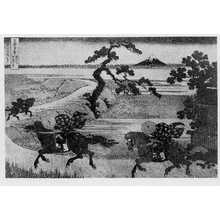Japanese Print "Sekiya Village on the Sumidagawa" by Katsushika Hokusai
Artist:Katsushika Hokusai
Title:Sekiya Village on the Sumidagawa
Date:c. 1830 - 1834
Details:More information...
Source:Honolulu Museum of Art
Browse all 5,476 prints...
Description:
The Sumida River, just over 14 1/2 miles long, originates in the Kanto Mountains. The river changes names in the length of its course: first it is called the Nakatsugawa, then the Arakawa, the Sumidagawa, and at its lower reaches, the Okawa or Asakusagawa. This major river flows north to south through the eastern half of Tokyo, connects a network of canals, and then empties into Tokyo Bay. Now as well as in the Edo period, the river was closely integrated into the life of the people; countless wholesale stores and warehouses were located along its banks. Sekiya was located to the north of the city of Edo proper, where the river was called Arakawa. The village was famous for beautiful scenery. Hokusai, however, depicts a dynamic scene of three pony express riders galloping along the dike above a stretch of marshy land. Mount Fuji recedes in the distance between a gnarled pine growing from the side of the dike and a tree in full foliage on the right. The structure in front shelters a government signboard where official proclamations and changes of law were posted. During the Edo period, a well-developed communication system employed runners (hikyaku) and pony riders (hayauma). Carrying mail, documents, and goods, these runners and horsemen transported them swiftly and on schedule. The official carriers were given so much priority and authority that no one could interfere with them. The riders in this print may well be government message carriers. Hokusai again draws on his studies of human and animal movements, convincingly depicting the horses and riders running at a furious pace. Again, the calm and immovable Fuji provides a contrast to the swift horses and riders and the sense of extreme urgency that they evoke. The key-block was prnted in blue. (Asian Art Museum of San Francisco, “Hokusai and Hiroshige”, 1998) A black mantle patterned with white well-frame kasuri motifs billows out behind a samurai galloping on horseback along a narrow county road. The dancing white patterns suggest the bounding energy of the horseman's body. Kasuri, or ikat, is another traditional technique used to embellish commoners' cotton garments with intricate designs. This complex and time-consuming process begins with the patterning of warp and/or weft threads prior to weaving. Wrapping certain segments of bundled threads and then dip-dyeing them creates the design. The wrapped threads resist the dye, resulting in sharply demarcated colored and uncolored sections. Wrapping and dyeing is repeated until the desired design is created on the threads. These pre-patterned threads are then meticulously woven, another time-consuming undertaking. (from “Blue and White” textiles exhibition 8/28/2008-) - - - - - - - - - - - - The Sumida, a relatively short river, originates in the Kanto Mountains. The river changes names in the length of its course: first it is called the Nakatsu-gawa, then the Arakawa, the Sumidagawa, and at its lower reaches, the Ökawa or Asakusagawa. This major river flows north to south through the eastern half of Tokyo, connects a network of canals, and then empties into Tokyo Bay. Now as well as in the Edo period, the river was closely integrated into the life of the people; countless wholesale stores and warehouses were located along its banks. Sekiya was located to the north of the city of Edo proper, where the river was called the Arakawa. The village was famous for beautiful scenery. Hokusai, however, depicts a dynamic scene of three pony express riders galloping along the dike above a stretch of marshy land. Mount Fuji recedes in the distance between a gnarled pine growing from the side of the dike and a tree in full foliage on the right. The structure in front shelters a government signboard where official proclamations and changes of law were posted. During the Edo period, well-developed communication system employed runners (hikyaku) and pony riders (hayauma). Carrying mail, documents, and goods, these runners and horsemen transported them swiftly and on schedule. The official carriers were given so much priority and authority that no one could interfere with them. The riders in this print may well be government message carriers. Hokusai again draws on his studies of human and animal movements, convincingly depicting the horses and riders running at a furious pace. Again, the calm and immovable Fuji provides a contrast to the swift horses and riders and the sense of extreme urgency that they evoke. The key-block was printed in blue. (The Asian Art Museum of San Francisco, HOKUSAI AND HIROSHIGE – Great Japanese Prints from the James A. Michener Collection, Honolulu Academy of Arts: The Asian Art Museum of San Francisco, 1998 Page 86. Cat. 37)
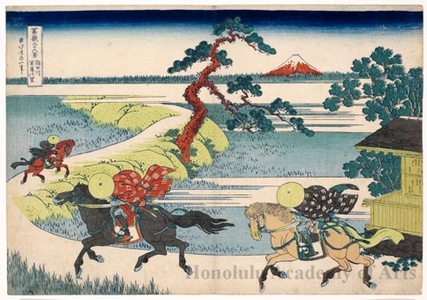
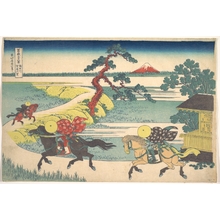
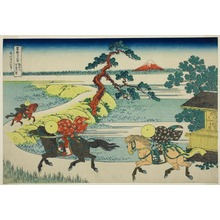
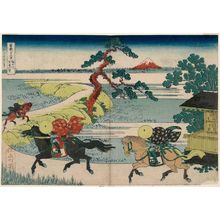

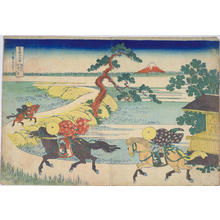
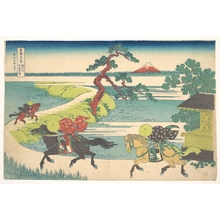
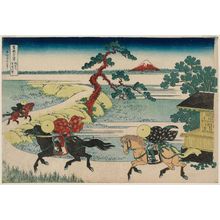

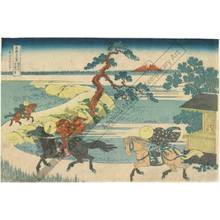
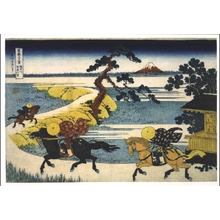
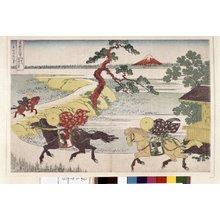
![Sumida-gawa Sekiya no sato 隅田川関屋ノ里 (Sekiya Villages on the Sumida River [Edo]) / Fugaku sanju-rokkei 冨嶽三十六景 (Sekiya Villages on the Sumida River [Edo]) Japanese Print "Sumida-gawa Sekiya no sato 隅田川関屋ノ里 (Sekiya Villages on the Sumida River [Edo]) / Fugaku sanju-rokkei 冨嶽三十六景 (Sekiya Villages on the Sumida River [Edo])" by Katsushika Hokusai, 葛飾北斎 (Katsushika Hokusai (葛飾北斎))](https://data.ukiyo-e.org/bm/thumbs/AN00115794_001_l.jpg)
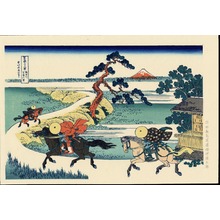
![[Sumidagawa sekiya no sato] Japanese Print "[Sumidagawa sekiya no sato]" by Katsushika Hokusai, 葛飾北斎 (Katsushika Hokusai)](https://data.ukiyo-e.org/loc/thumbs/02482v.jpg)
